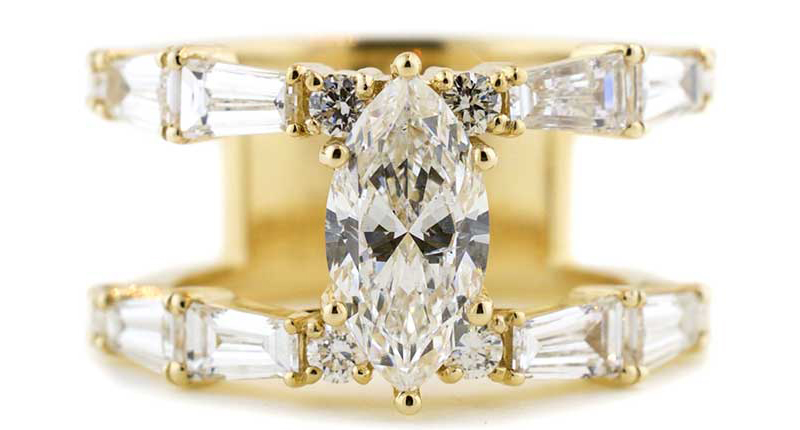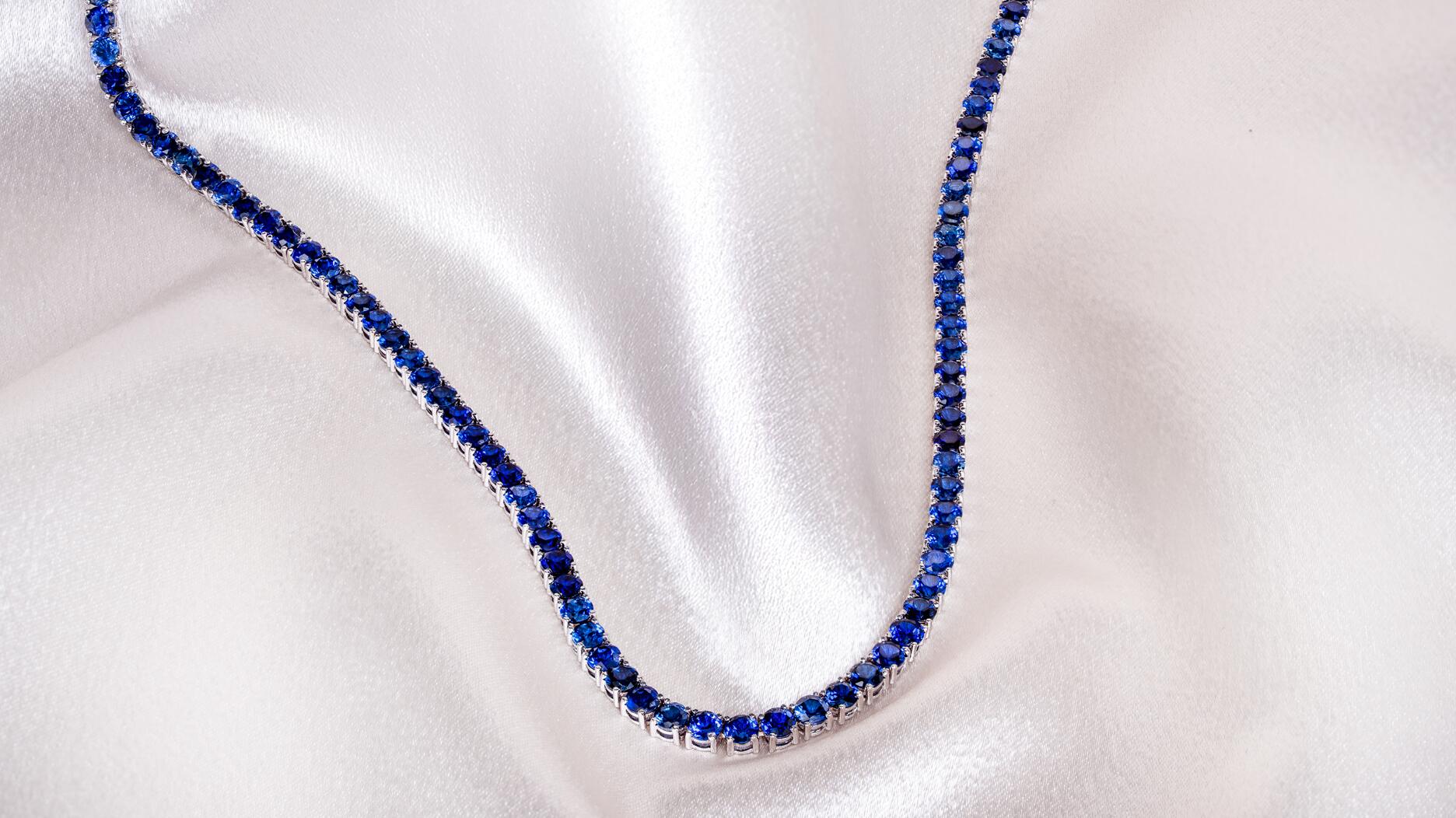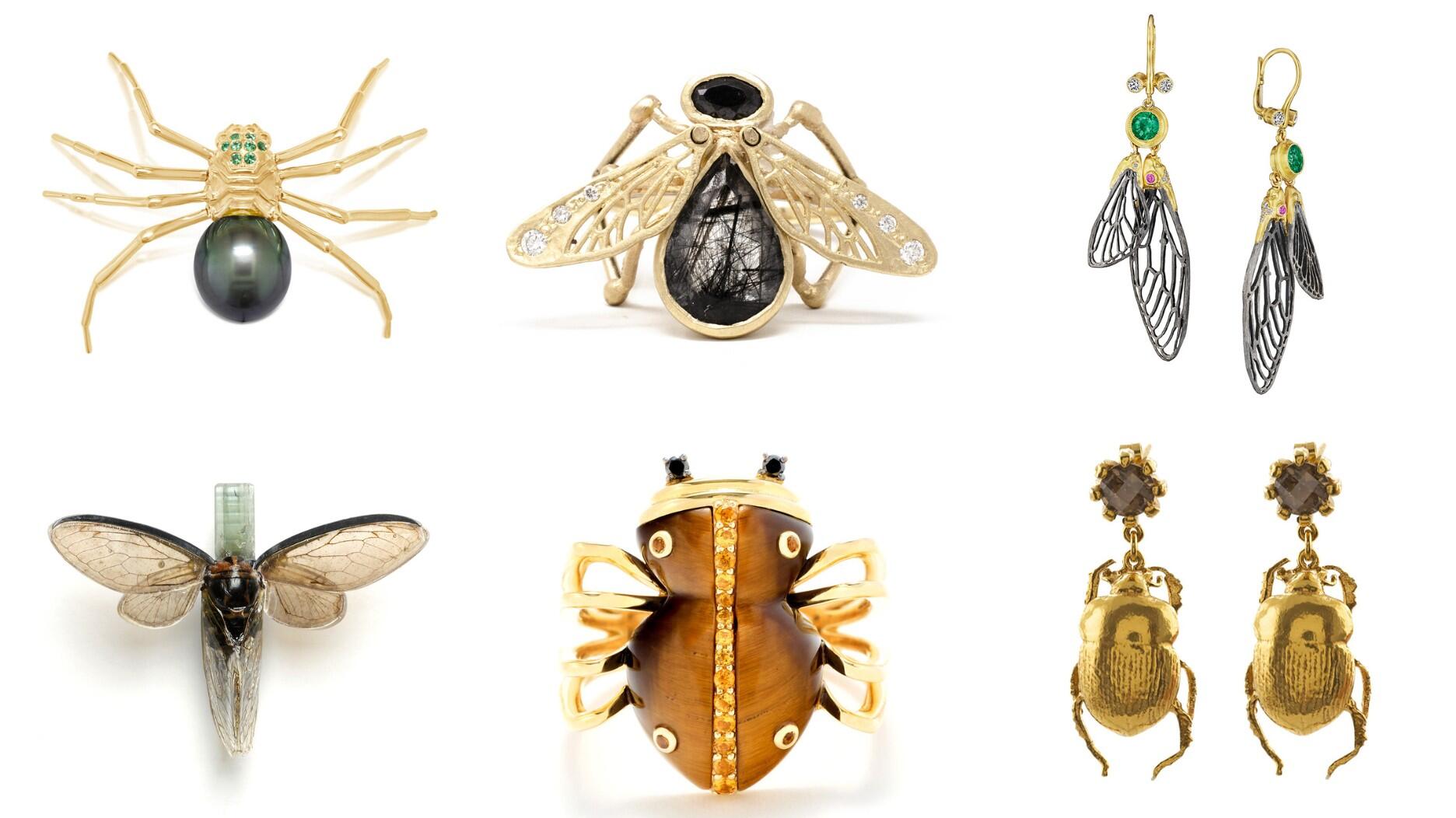Set in a Tiffany & Co. necklace, it sold for $4.2 million, the highest price and price per carat paid for a Paraíba tourmaline at auction.
In the First Half of 2018, Consumers Searched For …
Cushion-cut diamonds, for one, Editor-in-Chief Michelle Graff reports after digesting the latest data from GemFind.

In April, I relayed the results of GemFind’s first annual report aggregating data from the jewelers’ websites that the company manages; the report told us what diamonds consumers were clicking on the most—though not necessarily buying—when browsing jewelry online.
GemFind President and CEO Alex Fetanat told me at the time that his technology company, which he founded in 1999, wanted to make a habit out of publishing these reports, providing the industry with consumer data regularly.
A few weeks ago, he reached out to share results from the semi-annual report for 2018, detailing clicks for the first six months of the year (Jan. 1 through June 30).
Below, I share five of the most interesting points from the report; the entire analysis can be viewed on the GemFind website.
1. The overall profile of the diamond most searched for by consumers didn’t change from 2017, which is not surprising.
According to GemFind, consumers looked for a 1-carat, round, G color diamond with VS2 clarity and a Gemological Institute of America grading report, which is pretty much the same diamond most consumers were looking for last year.
New for the semi-annual report, however, was the inclusion of consumer preference for cut grade, with excellent coming in first (65 percent) of searches for diamonds bigger than 0.25 carats, followed by very good at 19 percent and good at 9 percent.
2. After G, the most searched for diamond color was …
H at 15 percent, followed closely by F (14 percent) and I (13 percent). All told, 59 percent of diamond searches were for stones between F and I in color.
The two highest diamond color grades, D and E, were clicked on by 8 and 11 percent of consumers, respectively.
Fetanat said he was surprised to see I-color diamonds finishing ahead of both D and E but noted that, “I is definitely not the greatest color, but it’s more affordable.”
3. After VS2, the most searched for diamond clarity was …
SI1 and VS1 were tied as the second most searched for clarities, garnering 18 percent of searches in the first six months of the year, followed by SI2 at 15 percent, VVS2 at 10 percent and VVS1 at 8 percent.
Very few consumers were looking for diamonds that were internally flawless—IF diamonds accounted for 4 percent of searches—or at the other end of the clarity spectrum. Only
What this data tells Fetanat: For the most part, consumers are looking for eye-clean diamonds, meaning they don’t want a stone with visible flaws, but they don’t feel the need to pay money for a flawless diamond either.

4. There was a bit of a shift in shape searches.
As noted above, the most searched for diamond shape was round, with the classic cut accounting for nearly 50 percent of searches in the first six months of 2018.
In second place, however, was not the princess cut or even the oval, which leapfrogged the princess to become the second most searched for cut shape of 2017.
It was the cushion, accounting for 11 percent of searches, followed closely by oval at 10 percent and the princess at 9 percent. Together with round diamonds, these three shapes accounted for more than three-quarters of all cut shape searches in the first six months of the year.
Other searched for shapes were: Asscher (7 percent), emerald (5 percent), radiant (4 percent), pear (3 percent) and marquise (2 percent).
5. There is solid interest in diamonds larger than 3 carats.
In the first six months of 2018, 46 percent of diamond searches were for 1-carat (25 percent), 3/4-carat (12 percent) and 1 1/2-carat diamonds (9 percent), none of which is surprising. Most consumers go for a diamond that is 1 carat exactly, or just under or above the 1-carat mark.
However, the third most searched for size (after 1 carat and 3/4 carat) was 3 carats and above, searched for by 11 percent of consumers.
Fetanat noted a couple of plausible reasons for the percentage of large diamond searches, including an improving economy and consumers searching not for engagement diamonds but for stones to mark milestone anniversaries, such as 10 or 20 years.
I also threw out a possibility with which Fetanat agreed—some consumers could be searching for larger diamonds simply out of curiosity. They want to see how much it would cost to buy a 4-carat diamond, or see what a 5-carat stone would look like on their finger, much in the same way one might look to see what $5,000 a month in rent will get you in Brooklyn (answer: not as much as you might think).
Jewelers, what do you think of the results of GemFind’s 2018 semi-annual survey? Do they match what you see consumers inquiring about and buying in your stores?
The Latest

The jeweler’s “Deep Freeze” display showcases its iconic jewelry designs frozen in a vintage icebox.

Take luxury gifting to new heights this holiday season with the jeweler’s showstopping 12-carat sphene ring.

How Jewelers of America’s 20 Under 40 are leading to ensure a brighter future for the jewelry industry.

This year's theme is “Unveiling the Depths of the Ocean.”


In its annual report, Pinterest noted an increase in searches for brooches, heirloom jewelry, and ‘80s luxury.

Starting Jan. 1, customers can request the service for opal, peridot, and demantoid garnet.

Roseco’s 704-page catalog showcases new lab-grown diamonds, findings, tools & more—available in print or interactive digital editions.

The 111-year-old retailer celebrated the opening of its new location in Salem, New Hampshire, which is its third store in the state.

The new catalog features its most popular chains as well as new styles.

The filmmaker’s personal F.P. Journe “FFC” prototype was the star of Phillips’ recent record-setting watch auction in New York.

The new location in the Design District pays homage to Miami’s Art Deco heritage and its connection to the ocean.

Inflations, tariffs, and politics—including the government shutdown—were among consumers’ top concerns last month.

“Longtime favorite” presenters, as well as first-time speakers, will lead talks and workshops at the annual event in Tucson next year.

Silas Smith of Meridian Metalworks won the challenge with his pendant that blends Australian and American landscapes.

The sale of the 31.68-carat, sunset-hued stone was part of Sotheby’s first series of events and auctions in Abu Dhabi.

Most customers who walk into your store this month have made up their minds. Your job is to validate their choice, Emmanuel Raheb writes.

The collection features characters and motifs from Ukrainian folklore, including an enchanted mirror and a magic egg.

MatrixGold 3.11, the newest version of the jewelry design program, offers more flexibility, precision, and creative control.

The pavilion will be part of the 2026 JA New York Spring show, scheduled for March 15 to 17.

Kadet, a 1994 National Jeweler Retailer Hall of Fame inductee, helped grow the family-owned retailer in the Chicago area and beyond.

Billed as the world’s smallest wearable, Lumia Health’s new smart earrings have a health tracker subtly embedded in the back.

Don’t let those with December birthdays feel blue. Help them celebrate their month with blue zircon, turquoise, and tanzanite.

The new pink sapphire version of the piece dances with its wearer in the brand’s “Icons After Dark” holiday campaign.

A choice that’s generated a lot of commentary, Pantone says “Cloud Dancer” marks a fresh start and encourages relaxation and creativity.

The manufacturer’s holiday campaign features a gift guide filled with trending designs and jewelry that can be personalized.

The man was charged with theft, accused of ingesting the necklace while in a jewelry store in Auckland, New Zealand.


























